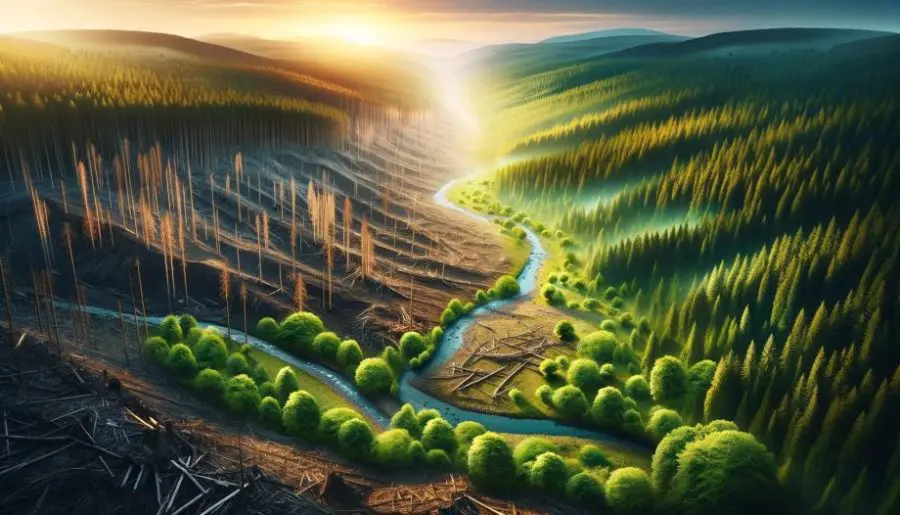
Explore the role of reforestation in carbon sequestration, a key strategy in our fight against climate change, fostering a greener and healthier planet.
The Role of Reforestation in Carbon Sequestration Key Takeaways:
- The role of reforestation in carbon sequestration is vital in combating climate change.
- It involves planting trees to absorb atmospheric CO2, a major greenhouse gas, and storing it as biomass and soil carbon.
- This natural process not only reduces carbon levels in the atmosphere but also enhances biodiversity and ecosystem resilience, thus making reforestation a key strategy for a sustainable future.
Unveiling the role of reforestation in carbon sequestration – it’s not just about planting trees but nurturing a future where nature and climate resilience go hand in hand.
In this journey, we explore how revitalizing our forests plays a pivotal role in capturing carbon, restoring ecosystems, and shaping a sustainable world.
Join us as we delve into the green heart of climate action.
The Role of Reforestation in Carbon Sequestration
Brief Overview of Climate Change and the Need for Effective Solutions
Climate change is a pressing global issue characterized by rising temperatures, changing weather patterns, and increasing levels of greenhouse gases in the atmosphere.
These changes are largely driven by human activities, such as the burning of fossil fuels and deforestation.
The need for effective solutions to mitigate climate change is urgent, and reforestation emerges as a key strategy in this battle.
Introduction to Reforestation as a Key Nature-Based Solution
Reforestation, the process of planting trees in areas where forests have been depleted, is a powerful nature-based solution to climate change.
It’s not just about planting new trees; it’s a comprehensive approach that involves restoring entire ecosystems.
Reforestation helps in capturing atmospheric carbon dioxide (CO2), a major contributor to global warming, and storing it in the form of biomass and soil carbon.
This introduction sets the stage for the detailed exploration of how reforestation contributes to carbon sequestration and the broader fight against climate change.
We will delve into the science behind carbon capture by forests, the global efforts in reforestation, and the challenges and potentials of these endeavors.
Overview of Reforestation and Carbon Sequestration
| Topic | Description |
|---|---|
| Climate Change | A global issue with rising temperatures and changing weather patterns due to greenhouse gases. |
| Role of Reforestation | Planting trees to restore ecosystems, capture CO2, and store carbon in biomass and soil. |
| Carbon Sequestration | Process of capturing and storing atmospheric CO2 to mitigate climate change. |
II. Understanding Carbon Sequestration
Dive into the fascinating world of carbon sequestration, a natural ally in our fight against climate change.
In this section, we’ll unravel how this process helps mitigate global warming by capturing atmospheric carbon dioxide and spotlight the indispensable role of forests as nature’s carbon reservoirs.
In the following paragraphs, we’ll explore the mechanisms of carbon sequestration, emphasizing its importance in climate change mitigation and the vital role forests play in this natural process.
Explanation of Carbon Sequestration and Its Importance in Mitigating Climate Change
Carbon sequestration is a natural or artificial process by which carbon dioxide (CO2) is removed from the atmosphere and stored in a carbon pool.
This process is critical in mitigating climate change as it helps reduce the amount of CO2, a key greenhouse gas, in the atmosphere.
Elevated levels of CO2 contribute to global warming by trapping heat, leading to rising global temperatures and climate instability.
By capturing and storing atmospheric CO2, carbon sequestration plays a vital role in slowing down the rate of climate change and helping to stabilize the global climate.
The Role of Forests in Capturing and Storing Carbon
Forests are one of the most effective carbon sinks on our planet. Through the process of photosynthesis, trees and other vegetation absorb CO2 from the atmosphere and convert it into organic matter, storing it in their biomass (trunks, branches, leaves, and roots) and the soil.
- Above-Ground Carbon Storage: Trees store carbon in their trunks, branches, and foliage. This storage plays a significant role in carbon sequestration, especially in mature forests where a large amount of biomass accumulates over time.
- Below-Ground Carbon Storage: Forest soils are also significant carbon stores. The organic matter from dead and decaying plant material, including fallen leaves and branches, contributes to the soil’s organic carbon content. Moreover, the root systems of trees and other forest vegetation contribute to carbon storage below ground.
- Global Reforestation Efforts: Reforestation activities, which involve planting trees in areas where forests have been depleted, enhance the carbon storage capacity of these areas. Reforestation not only helps restore the forest cover but also revitalizes the soil’s ability to store carbon.
Mechanisms of Carbon Sequestration in Forests
| Component | Description |
|---|---|
| Above-Ground Storage | Trees store carbon in trunks, branches, and leaves, contributing to biomass accumulation. |
| Below-Ground Storage | Soil stores carbon from dead plant material and root systems, enhancing soil organic carbon content. |
Forests, therefore, play a dual role in carbon sequestration – directly through biomass and indirectly through soil carbon storage.
Protecting existing forests and expanding forested areas through reforestation are key strategies for leveraging the power of nature to combat climate change.
In the next section, we will explore global reforestation efforts and their impact on carbon sequestration, including specific examples and quantifications of their contribution to mitigating climate change.
III. Reforestation: An Effective Tool for Carbon Capture

Step into the green world of reforestation, a key strategy in our environmental toolkit for combating climate change.
Here, we’ll explore how reforestation significantly bolsters carbon sequestration efforts.
Delving into the scientific intricacies, we’ll uncover the mechanisms of above-ground and below-ground carbon storage in forests, and how they collectively contribute to reducing atmospheric carbon dioxide levels.
This section will provide an in-depth view of reforestation’s role in carbon sequestration, from the intricacies of forest growth to the broader impacts on global carbon cycles.
Overview of How Reforestation Contributes to Carbon Sequestration
Reforestation is the process of planting trees in areas where forests have been cut down or degraded.
It’s a pivotal strategy in carbon sequestration for several reasons:
- Enhancing Carbon Absorption: New trees absorb CO2 as they grow, increasing the carbon capture capacity of an area. This is particularly effective in tropical regions, where trees grow quickly and can sequester significant amounts of carbon in a relatively short period.
- Restoring Ecosystems: Reforestation helps restore ecosystems, which are natural carbon sinks. Healthy ecosystems are more resilient and efficient in carbon sequestration than degraded ones.
- Long-Term Carbon Storage: Mature forests store carbon for decades or even centuries, making reforestation a long-term solution for carbon sequestration.
The Science Behind Above-Ground and Below-Ground Carbon Storage in Forests
- Above-Ground Carbon Storage:
- Trees capture carbon through photosynthesis and store it in their biomass (leaves, branches, trunks).
- The amount of carbon stored depends on the tree species, age, and health of the forest. Older and larger trees, for example, can store more carbon.
- Below-Ground Carbon Storage:
- Forest soils are significant carbon stores. When leaves, branches, and trees die, they decompose and become part of the soil organic matter, trapping carbon underground.
- The root systems of trees also contribute to carbon storage in the soil.
- Factors Affecting Carbon Storage:
- The effectiveness of reforestation in carbon storage depends on various factors, including the type of trees planted, soil quality, and local climate conditions.
- Reforestation in tropical regions is often more effective in carbon sequestration due to faster tree growth rates and year-round growing conditions.
Reforestation is not just about planting trees but about creating and maintaining healthy forest ecosystems that can continue to absorb and store carbon over time.
It’s a crucial component in the fight against climate change, with the potential to significantly reduce atmospheric CO2 levels.
IV. Global Reforestation Efforts and Their Impact
Witness the global endeavor of reforestation, where initiatives worldwide are turning barren lands back into lush forests.
This section highlights notable large-scale reforestation projects across the globe, their outcomes, and the significant role they play in carbon capture and climate change mitigation.
Examples of Large-Scale Reforestation Projects and Their Outcomes

- The Great Green Wall, Africa: The Great Green Wall is an ambitious project that aims to combat desertification across the Sahel region by creating a 7,775 km long and 15 km wide mosaic of trees, grasslands, and vegetation across 11 countries. It not only aids in carbon sequestration but also improves food security and resilience against climate impacts for millions.
- China’s Reforestation Initiatives: China has implemented several large-scale reforestation projects, like the Grain for Green program, which has significantly increased forest cover in the country. These projects have helped restore degraded lands, improve air quality, and enhance carbon sequestration.
- Reforestation in the Amazon, Brazil: Efforts to reforest parts of the Amazon Rainforest, which have been heavily deforested in recent decades, are critical. These projects focus on restoring one of the world’s largest carbon sinks, vital for global climate regulation.
Quantifying the Carbon Capture Potential of These Projects
- Carbon Sequestration Metrics: Various studies have quantified the carbon capture potential of reforestation efforts. For instance, reforestation in the United States can sequester up to 2 Pg of carbon in topsoils over a century.
- Impact Assessment: The effectiveness of these reforestation projects in carbon sequestration is evaluated based on factors like the number of trees planted, the types of trees, and the health of the ecosystems restored.
- Global Significance: Reforestation projects, particularly in regions like the tropics, where tree growth is rapid, can significantly contribute to the global carbon budget. The carbon sequestration potential of these projects is crucial in efforts to meet international climate targets.
Global Reforestation Efforts
| Project/Region | Description |
|---|---|
| Great Green Wall, Africa | Aims to combat desertification across the Sahel region, improving carbon sequestration and ecosystems. |
| China’s Initiatives | Projects like the Grain for Green program increased forest cover, enhancing carbon storage. |
| Amazon, Brazil | Efforts to restore parts of the heavily deforested Amazon Rainforest, a major carbon sink. |
Reforestation projects worldwide illustrate the potential of concerted, large-scale environmental efforts in mitigating climate change.
They serve as a testament to the power of reforestation as a key strategy in carbon sequestration and ecological restoration.
V. Reforestation, Soil Carbon, and Ecosystem Health
Delve into the often-overlooked aspect of reforestation – its impact on soil carbon and ecosystem health.
This section explores how reforestation not only enriches the above-ground environment but also plays a pivotal role in enhancing soil health, contributing to the resilience and vitality of entire ecosystems.
The Significance of Soil Carbon Sequestration in Reforestation Efforts
- Soil as a Carbon Sink: Soil is one of the largest carbon sinks on Earth. Reforestation increases the amount of organic matter in the soil, which translates into greater carbon storage capacity.
- Mechanism of Soil Carbon Sequestration: When trees grow, they not only store carbon in their biomass but also contribute to soil carbon through leaf litter, root biomass, and other organic matter that gets integrated into the soil, enhancing its carbon content.
- Impact on Climate Change Mitigation: Increasing soil carbon storage through reforestation is a key strategy in mitigating climate change. Enhanced soil carbon sequestration can significantly contribute to reducing atmospheric CO2 levels.
How Reforestation Improves Soil Health and Overall Ecosystem Resilience
- Enhancing Soil Fertility and Structure: Reforestation improves soil fertility by increasing organic matter, which enhances soil structure, water retention, and nutrient availability.
- Boosting Ecosystem Productivity: Healthy soils lead to more productive ecosystems. They support a wider range of plant and animal life, contributing to biodiversity and ecosystem resilience.
- Preventing Soil Erosion and Degradation: Tree roots help stabilize soil, reducing erosion, and preventing land degradation. This is particularly important in areas prone to soil erosion due to deforestation or intensive agricultural practices.
Reforestation initiatives, therefore, contribute significantly to the health and resilience of ecosystems.
By focusing on both above-ground and below-ground impacts, reforestation becomes a comprehensive solution to environmental restoration and climate change mitigation.
This section emphasizes the importance of soil health in reforestation efforts and its broader impact on ecosystem resilience
VI. Challenges and Considerations in Reforestation
Reforestation, while a powerful tool against climate change, comes with its own set of challenges and considerations.
This section sheds light on potential obstacles like monoculture planting and land use conflicts and underscores the importance of biodiversity and native species in reforestation efforts.
Addressing Potential Challenges in Reforestation
- Monoculture Planting: Monoculture, or the planting of a single tree species, can lead to ecological imbalances. It’s less effective in supporting biodiversity, can be more susceptible to diseases and pests, and may not provide the same level of ecosystem services as diverse forests.
- Land Use Conflicts: Reforestation efforts can sometimes conflict with other land uses, such as agriculture or urban development. Balancing the needs for reforestation with those of local communities and industries is crucial.
- Sustainable Management Practices: Implementing sustainable management practices in reforestation efforts is key. This includes considering long-term ecological impacts and ensuring that reforestation does not lead to unintended environmental consequences.
The Importance of Biodiversity and Native Species in Reforestation Efforts
- Biodiversity Benefits: Diverse forests support a wider range of flora and fauna, leading to healthier and more resilient ecosystems. Biodiversity is crucial for ecosystem services like pollination, water purification, and soil fertility.
- Native Species Preference: Using native species in reforestation projects is vital. Native trees are generally better adapted to local conditions and support local wildlife more effectively. They also maintain the natural character and ecological balance of the region.
- Long-Term Ecological Health: The focus on biodiversity and native species contributes to the long-term health and sustainability of forests. It ensures that reforested areas can withstand environmental changes and continue to provide crucial ecosystem services.
Challenges and Considerations in Reforestation
| Challenge | Description |
|---|---|
| Monoculture Planting | Planting a single species can lead to ecological imbalances and is less effective for biodiversity. |
| Land Use Conflicts | Balancing the needs for reforestation with local communities and industries is crucial. |
| Biodiversity Importance | Diverse forests support a wide range of wildlife and provide robust ecosystem services. |
Reforestation is a complex process that requires careful planning and execution.
Addressing the challenges and prioritizing biodiversity and the use of native species is essential for the success and sustainability of reforestation projects.
This section covers the challenges in reforestation and the importance of biodiversity and native species.
VII. Economic and Social Benefits of Reforestation
Reforestation is more than an environmental initiative; it’s a catalyst for economic growth and social enhancement.
This section highlights the economic impacts of reforestation, including job creation and sustainable development, and explores the social benefits, like community involvement and the integration of indigenous knowledge.
Economic Impacts of Reforestation
- Job Creation: Reforestation projects create jobs in tree planting, forest management, and monitoring. These jobs are often in rural areas, where employment opportunities can be scarce.
- Sustainable Development: By contributing to a healthier environment, reforestation supports sustainable development. It also provides raw materials for various industries, promoting economic growth.
- Boosting Eco-Tourism: Reforested areas can become attractions for eco-tourism, generating revenue for local communities and businesses.
Social Benefits of Reforestation
- Community Involvement: Reforestation projects often involve local communities, fostering a sense of ownership and responsibility towards the environment. This involvement can lead to enhanced community cohesion and empowerment.
- Incorporating Indigenous Knowledge: Indigenous communities have deep-rooted knowledge about their local ecosystems. Including this knowledge in reforestation efforts can lead to more effective and culturally sensitive practices.
- Educational Opportunities: Reforestation provides educational opportunities for locals and visitors alike, raising awareness about environmental issues and the importance of forests.
Economic and Social Benefits of Reforestation
| Benefit Type | Description |
|---|---|
| Job Creation | Creates jobs in tree planting, forest management, and monitoring, especially in rural areas. |
| Sustainable Development | Contributes to a healthier environment and provides materials for industries, promoting economic growth. |
| Community Involvement | Involves local communities, fostering a sense of ownership and environmental responsibility. |
Reforestation, therefore, has far-reaching economic and social benefits, contributing to community development, cultural enrichment, and economic stability.
VIII. Future Directions and Potential of Reforestation
As we venture forward, reforestation stands at the forefront of climate change mitigation strategies.
This section examines the emerging research and innovations in reforestation for carbon sequestration and explores the potential for scaling up these efforts on a global scale.
Emerging Research and Innovations in Reforestation for Carbon Sequestration
- Advancements in Reforestation Techniques: Recent studies and projects are exploring new ways to enhance the carbon sequestration potential of reforestation. This includes the use of biochar in planting processes, which has shown to effectively increase carbon capture in the initial years after planting.
- Lifecycle Assessments of Reforestation Projects: Research is now focusing on the total carbon impact of reforestation, considering all aspects from nursery to field. These comprehensive assessments help in understanding the true carbon footprint of reforestation efforts and guiding more efficient practices.
- Innovative Models for Predicting Carbon Sequestration: New models are being developed to better predict the carbon sequestration potential of reforested areas, taking into account various factors like soil type, climate, and tree species.
The Potential for Scaling Up Reforestation Efforts Globally
- Global Reforestation Targets: With the increasing recognition of reforestation as a key nature-based solution, there is potential for significant scaling up of reforestation efforts worldwide. This includes both tropical and temperate regions, each offering unique opportunities for carbon capture.
- Collaboration and Funding: For large-scale reforestation to be successful, collaboration between governments, NGOs, and the private sector is crucial. Securing funding and developing international partnerships are key factors in expanding reforestation efforts.
- Integrating Local Communities: The success of reforestation projects also depends on the involvement and support of local communities. Ensuring that reforestation projects bring social and economic benefits to local populations will be crucial for their long-term success and sustainability.
Future Directions in Reforestation
| Area of Focus | Description |
|---|---|
| Research and Innovation | Advancements in techniques and lifecycle assessments to enhance carbon sequestration. |
| Global Scaling | Potential for significant expansion of reforestation efforts worldwide with collaboration and funding. |
| Community Integration | Involvement and support of local communities are crucial for long-term success and sustainability. |
Reforestation as a strategy for carbon sequestration is evolving with new research and innovations.
By embracing these advancements and focusing on collaboration and community involvement, the potential to significantly scale up reforestation efforts globally is within reach, offering a promising path in the fight against climate change.
Sources: A study from Scientific Reports on assessing the carbon capture potential of reforestation projects (Nature.com) and an analysis by MIT News on how forests can cut carbon, restore ecosystems, and create jobs (MIT News).
Additionally, insights from a CINCIA study reveal the true carbon impact of reforestation (Sabin Center).
Reforestation and Carbon Sequestration
FAQs
As we delve into the complexities of reforestation and its role in carbon sequestration, you might have questions about how it all works and its broader impacts.
In this FAQ section, we’ve compiled some of the most commonly asked questions to clarify these concepts and shed light on the essential aspects of reforestation as a strategy against climate change.
Whether you’re a curious reader or an avid environmental enthusiast, these answers aim to enhance your understanding and appreciation of reforestation’s crucial role in our environment.
Now, let’s explore these common questions and their answers to gain a deeper insight into reforestation and carbon sequestration.
Q: What is carbon sequestration, and how does reforestation contribute to it?
A: Carbon sequestration is the process of capturing and storing atmospheric carbon dioxide.
Reforestation contributes to this by planting trees that absorb CO2 as they grow, storing it in their biomass and the soil.
Q: Why is biodiversity important in reforestation projects?
A: Biodiversity is crucial in reforestation as it ensures ecosystem resilience and health.
Diverse species of trees and plants support a wider range of wildlife and provide more robust ecosystem services.
Q: Can reforestation significantly impact global carbon levels?
A: Yes, reforestation can have a significant impact on global carbon levels, especially when implemented on a large scale.
Forests are major carbon sinks and can store vast amounts of CO2.
Q: What are some challenges in implementing reforestation projects?
A: Challenges include addressing land use conflicts, avoiding monoculture planting, ensuring the survival of new saplings, and integrating local community needs and knowledge.
Q: How can individuals contribute to reforestation efforts?
A: Individuals can contribute by supporting reforestation initiatives, participating in local tree-planting events, donating to environmental organizations focused on reforestation, and advocating for policies that support reforestation.
Q: Are there economic benefits to reforestation?
A: Yes, reforestation can stimulate economic growth by creating jobs, supporting sustainable industries like eco-tourism, and improving agricultural productivity through ecosystem services.
Q: How does reforestation affect soil health?
A: Reforestation improves soil health by increasing organic matter, enhancing soil structure and fertility, and reducing erosion. Healthy soils further aid in carbon sequestration.
Q: Can reforestation occur in urban areas?
A: Yes, urban reforestation is possible and beneficial. It includes planting trees in parks, along streets, and on rooftops. Urban trees help in air purification, and temperature regulation, and provide recreational spaces.
IX. Reforestation in Carbon Sequestration Conclusion
As we draw our exploration of reforestation in carbon sequestration to a close, let’s reflect on the significant insights gained.
Reforestation emerges not just as an environmental strategy but as a beacon of sustainable change and ecological hope.
In this concluding section, we’ll summarize the critical role of reforestation in combating climate change and highlight the ongoing need for research, investment, and public support.
Read more: Nature-Based Solutions to Climate Change
In the following paragraphs, we’ll encapsulate the essence of reforestation’s impact on our planet and the collective action required to harness its full potential.
Summarizing the Role of Reforestation in Combating Climate Change:
Reforestation stands as a beacon of hope in the ongoing battle against climate change.
Throughout this post, we’ve explored its multifaceted role – from capturing and storing significant amounts of carbon to restoring and maintaining healthy ecosystems.
The evidence is clear: reforestation is more than just planting trees; it’s about nurturing entire ecosystems that are crucial for the Earth’s climate stability.
Encouraging Continued Research, Investment, and Public Support for Reforestation Efforts:
The journey doesn’t end here. Continued research and innovation in reforestation are essential to enhance its effectiveness and efficiency in carbon sequestration.
Investment, both public and private, is crucial to expand reforestation efforts globally, especially in regions most affected by deforestation.
Public support and awareness are equally vital. Every individual can contribute to this cause, be it through supporting policies that favor reforestation, participating in local tree-planting initiatives, or simply spreading awareness about the importance of reforestation.
As we look ahead, let’s recognize and harness the power of reforestation in creating a sustainable and resilient future. Together, through collective effort and commitment, we can make a significant impact in mitigating climate change and preserving our planet for future generations.
Read more: Protecting Coastal Ecosystems
X. References and Further Reading
To deepen your understanding of reforestation and its role in carbon sequestration, consider exploring the following sources and materials:
- Assessing the carbon capture potential of a reforestation project – Scientific Reports: This study provides an in-depth analysis of the carbon capture potential of reforestation, focusing on above- and below-ground carbon modeling. Read more
- Reforestation Can Sequester Globally Significant Amounts of Soil Carbon – Environmental System Science Program: Discusses the role of reforestation in soil carbon sequestration, emphasizing the importance of this aspect in climate change mitigation. Read more
- The role of reforestation in carbon sequestration – Argonne National Laboratory: Offers insights into various aspects of how reforestation contributes to carbon sequestration. Read more
- Forests and Climate Change – MIT Climate Portal: This resource covers the relationship between forests and climate change, including the role of forests in carbon fluxes. Read more
- Forests and Decarbonization – Roles of Natural and Planted Forests – Frontiers: Explores the different roles of natural and planted forests in carbon management and decarbonization efforts. Read more
- Soil carbon sequestration accelerated by restoration of grassland biodiversity – Nature Communications: Provides insights into how restoration projects, including reforestation, can enhance soil carbon sequestration. Read more
- Potential and constraints of reforestation for climate mitigation – ScienceDaily: Discusses the potential of reforestation as a climate change mitigation strategy and its constraints. Read more
- How trees and forests reduce risks from climate change – Nature Climate Change: An article focusing on the broader impact of trees and forests in reducing climate change risks. Read more
- Forests that regrow naturally may store more carbon – The Nature Conservancy: This study highlights the importance of natural forest regrowth in carbon sequestration. Read more
- The economic costs of planting, preserving, and managing the world’s forests to mitigate climate change – Nature Communications: Explores the economic aspects of forest management in the context of climate change mitigation. Read more
- The neglected role of abandoned cropland in supporting both food security and climate change mitigation – Nature Communications: An article that discusses the potential of reforesting abandoned cropland for climate change mitigation. Read more
These sources provide a comprehensive view of the various aspects of reforestation and its role in carbon sequestration and climate change mitigation.






